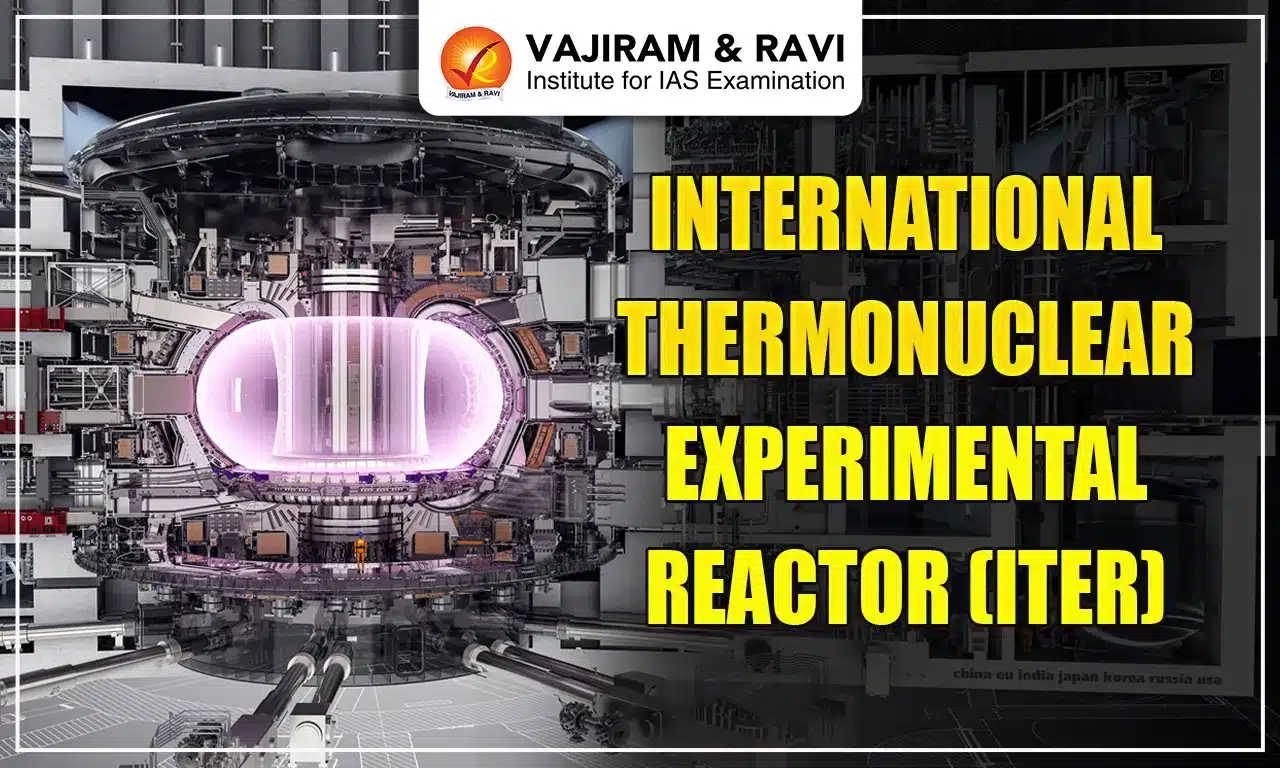International Thermonuclear Experimental Reactor is the most advanced and the world's largest Tokamak facilitating magnetic fusion reactions on a large scale to harness carbon-free and sustainable fusion energy. Currently under construction in France, the primary objective of the ITER is to attain "burning plasma" so that sufficient heat from the fusion reaction is retained within the plasma, thereby sustaining the fusion reaction for a longer duration.
ITER, the collaboration of 35 nations, is crucial for advancing fusion science and technology. It is an essential bridge between smaller-scale experimental fusion devices and future industrial fusion power plants.
What is the International Thermonuclear Experimental Reactor (ITER)?
International Thermonuclear Experimental Reactor is an international collaborative project for advancing magnetic fusion that includes 35 countries - the United States, China, India, Japan, Korea, the Russian Federation, and the European Union. It will not produce any electricity; instead, ITER will resolve the critical scientific and technical issues to take fusion to the point where industrial applications can be envisioned.
Objectives of ITER
This unique experimental marvel has been designed to investigate the following objectives:
- To investigate and demonstrate burning Plasma (Self-heating plasma)
- In a burning plasma, heat from the fusion is confined within the plasma itself efficiently enough for self-heating.
- ITER is the first burning plasma device in the world.
- To attain fusion gain of more than 10 for a longer duration of 400 to 600 seconds
- It intends to deliver ten times more thermal power (500 MW) than injected power heating systems (50 MW), thus attaining a gain factor of at least 10.
- Fusion gain (Q) is the measure of the ratio between the power produced by the fusion reactions and the external heating power that must be injected in a tokamak to sustain the reactions.
- Test tritium breeding
- The validity of tritium breeding module concepts that would lead in a future reactor to tritium self-sufficiency by producing tritium from lithium (lithium isotope Li-6).
- Demonstrate the safety characteristics of a fusion device
- Contribute to the demonstration of the integrated operation of technologies for a fusion power plant
Working Principle of ITER
ITER will work on the “Tokamak” concept where the reaction of Deuterium and Tritium (hydrogen isotopes) produces energy. A Tokamak facilitates magnetic confinement fusion that uses magnetic fields to contain the fusion fuel in plasma form.
- Burning plasma: To create plasmas with dominant self-heating, the size of the world's largest tokamak, ITER, will have a plasma radius of 6.2m and a plasma volume of 840m³.
- It will be twice the current largest tokamak fusion experiment, the JET reactor in the UK.
- The temperature of the plasma will be 150 million degrees Celsius, roughly 10 times as hot as the core of the Sun.
- The system will use four types of magnets to achieve plasma confinement:
- Central solenoid magnet
- Poloidal magnets
- Toroidal-field coils
- Correction coils
- Cryostat: It surrounds the vacuum vessel and superconducting magnets to ensure an ultra-cool, vacuum environment.
India’s Contribution to the ITER
India became a full partner of the ITER Project in 2005. It is intended to advance India's own nuclear fusion programmes and research. The Institute for Plasma Research (IPR), a dedicated research institute under the Department of Atomic Energy, supervises the ITER-India as well as India’s two tokamaks, ADITYA-U and SST-1.
- ITER-India: ITER-India is the Indian domestic agency and a specially empowered project of the IPR contributing to the ITER collaboration.
- It is responsible for the delivery of key ITER packages including Cryostat, In-wall Shielding, Cooling Water System, Cryogenic System, Ion-Cyclotron RF Heating System, Electron Cyclotron RF Heating System, Diagnostic Neutral Beam System, Power Supplies, and some Diagnostics.
- As a regular member, India contributes 9% of the operating costs.
Significance of ITER
Of all the magnetic confinement technology (tokamaks and stellarators), ITER is the most advanced version. The various significance of the ITER are as follows:
- Energy for the future: ITER is the experimental bridge between today's fusion machines, focused on and tomorrow's power plants based on nuclear fusion, the energy without GHG emission (Fossil fuels) and radiation (Fission reactor).
- Longevity: In the last 60 years of research on harnessing fusion energy, this is the first time that we have reached the threshold of "burning plasma". Once successful, the longevity of tokamak will be up to 400 to 600 seconds, which is much more than the current scenario.
- Sustainability: ITER aims to ensure a higher Fusion gain (Q) of more than 10, which increases its potential for sustainability.
- Study of plasma physics: The success of ITER will further encourage the pursuance of the study of Plasma physics which will add another dimension to plasma-based technology.
Challenges Associated with ITER
The challenges and risks associated with such a large project are mainly technical in nature, such as:
- Risk of Disaster: The radiation from fusion is very intense and could damage ordinary materials such as steel, which may lead to a severe disaster.
- Risk of Radiation Leakage: Since deuterium and tritium are used as radioactive fuels in ITER experiments, any operational error may trigger potential mishaps.
- Magnet quality issues: Magnets are expected to have better precision and quality. But several of the magnets experienced problems such as cracks and defects. Hence, the reduced quality can affect the functioning of tokamak.
- Installation and Integration Issues: The process of installation and integration of the various components of the ITER remains a challenging task as many critical systems, such as diagnostics, cooling, and vacuum systems, which are essential for achieving and sustaining a stable fusion reaction, are still in the developmental phase.
Last updated on November, 2025
→ Check out the latest UPSC Syllabus 2026 here.
→ Join Vajiram & Ravi’s Interview Guidance Programme for expert help to crack your final UPSC stage.
→ UPSC Mains Result 2025 is now out.
→ UPSC Notification 2026 is scheduled to be released on January 14, 2026.
→ UPSC Calendar 2026 is released on 15th May, 2025.
→ The UPSC Vacancy 2025 were released 1129, out of which 979 were for UPSC CSE and remaining 150 are for UPSC IFoS.
→ UPSC Prelims 2026 will be conducted on 24th May, 2026 & UPSC Mains 2026 will be conducted on 21st August 2026.
→ The UPSC Selection Process is of 3 stages-Prelims, Mains and Interview.
→ UPSC Result 2024 is released with latest UPSC Marksheet 2024. Check Now!
→ UPSC Prelims Result 2025 is out now for the CSE held on 25 May 2025.
→ UPSC Toppers List 2024 is released now. Shakti Dubey is UPSC AIR 1 2024 Topper.
→ UPSC Prelims Question Paper 2025 and Unofficial Prelims Answer Key 2025 are available now.
→ UPSC Mains Question Paper 2025 is out for Essay, GS 1, 2, 3 & GS 4.
→ UPSC Mains Indian Language Question Paper 2025 is now out.
→ UPSC Mains Optional Question Paper 2025 is now out.
→ Also check Best IAS Coaching in Delhi
International Thermonuclear Experimental Reactor FAQs
Q1. What is ITER Project?+
Q2. Which principle is used in the International Thermonuclear Experimental Reactor?+
Q3. What is the significance of the International Thermonuclear Experimental Reactor (ITER)?+
Q4. What is the contribution of India in ITER Project?+
Tags: international thermonuclear experimental reactor quest


















